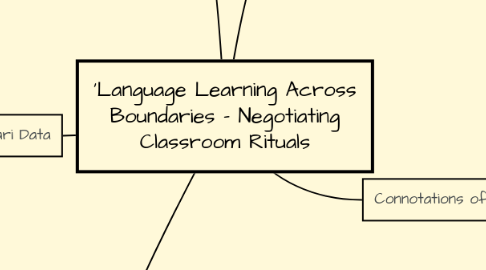
1. Repertoire of Limited Choices
1.1. Ritual in Conversation
1.1.1. The allowance of choices expands the structure of discussion to three or four parts instead of just two parts
1.1.2. Inserting Negotiations
1.1.2.1. Choices after an "R" - Negotiating responses where there are choices presented after an initial response that continues negotiation until a terminating "T" unit of interaction.
1.1.2.2. Choices after an "I" - Negotiating initiations where the choices are presented after the initiation in order to get a more specific response.
1.1.2.3. Choices after an "N" - Re-negotiating negotiations where the choice is presented after a previous negotiation.
1.1.3. Encapsulation and Prospection
1.1.3.1. Encapsulation: The retrieval of all previous contributions within a coherent unit
1.1.3.2. Prospection: When a speaker may attempt to manage or influence the future direction of the discourse.
1.1.4. Classroom example: Often times my mentor teacher will ask the class a question, to which a student will give an answer. The teacher will then take the student's answer and provide another choice, asking: "is it _______ or _______?"
2. Repetitive Structuring - Termination of Exchanges by Verbatim Repetition
2.1. "In 54% of all exchanges that a teacher terminates (more than 90% of all exchanges), the teacher repeats the student's or students' response verbatim, whether it is grammatically well-formed or not"
2.2. This process displays a more "fixed" approach in regards to the structure of discusssion
2.3. However, this allows for participants to engage in "lively interaction".
2.4. Classroom Example: In the classroom, my mentor teacher will ask a student to make a sentence using the spelling word "chicks". One student replies with: "I see two chicks at the farm yesterday." The teacher will then repeat the sentence, and then make the rest of the class repeat the sentence: "I see two chicks at the farm yesterday." Only then will she ask the class if there is anything the class can do to make the sentence better.
3. Exchange Structure - Qatari Data
3.1. Students often produced responses, very rarely did they produce initiations,
3.2. Teacher-fronted classrooms often see teachers as the initiator.
3.3. In the context of the study, most negotiations were also done by teachers looking for a "better" answer.
4. Connotations of "Ritual"
4.1. commonly associated with "rigid" and "meaningless"
4.2. According to McClaren: "constitutive of everyday human life, including secular activities", "thrive in the world of lived experience", "integrally related to everyday action"
4.2.1. Ex. of ritual events: eating at McDonald's
4.2.2. Ritual as a "framing device which embodies a repertoire of choices"
4.2.3. Classroom Example: Morning greeting rituals has the teacher asking each student: "What kind of day are we gonna have?" to which the student replies: "A great day!", gives the teacher a high-five and enters the classroom.
5. Teacher-Fronted Classrooms
5.1. Elicit Exchange
5.1.1. 3 part structure
5.1.1.1. Initiation
5.1.1.2. Response
5.1.1.3. Follow Up
5.1.2. Questions and answers are repeated but "nothing happens as a result".
5.1.3. Ex. In my mentor teacher's first grade ELD classroom, whenever she asks a student a question, she always has the student answer the question by repeating the question and then afterwards, she will repeat the student's answer once more to the entire class.
5.2. "Classroom Ritual"
5.2.1. "antithetical to classroom discussion"
5.2.2. Traditional teacher-fronted classroom shows a rigid structure in communication that does not represent how communication actually occurs in the "real world"

